5 componentes de design neumorfico em HTML, CSS e JavaScript
Neumorfismo é uma nova tendência de design que combina design plano e skeuomorfismo. É uma maneira minimalista de projetar com um plástico macio extrudado, quase em estilo 3D. Atualmente, este design é tendência na Internet e é amplamente utilizado por designers e desenvolvedores.
Se você quiser testar o neumorfismo em seu próximo projeto, aqui estão alguns trechos de código para você começar.
1. Cartões Neumórficos
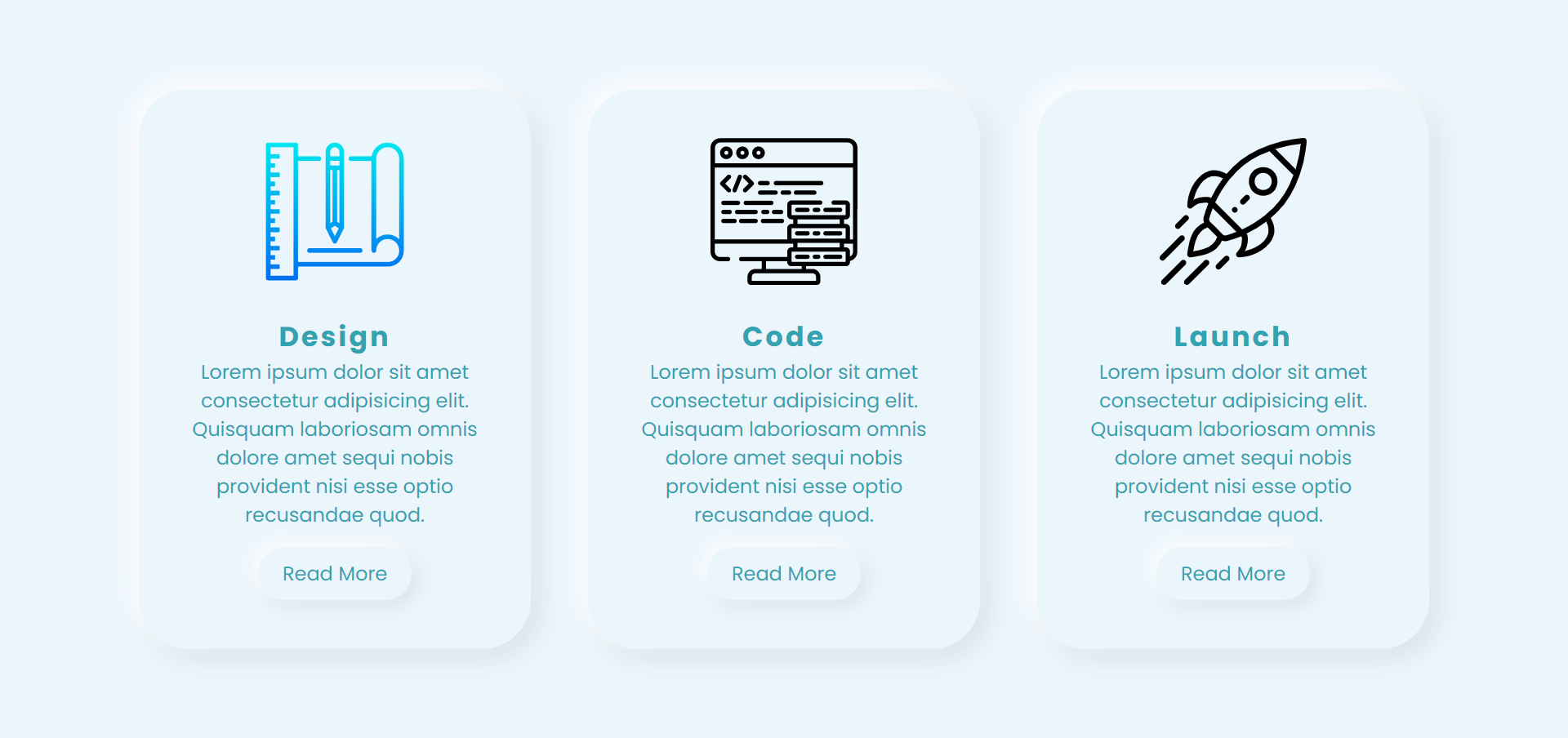
Use os seguintes trechos de código HTML e CSS para criar os cartões neumórficos acima.
Código HTML
<!DOCTYPE html>
<html lang="en" dir="ltr">
<head>
<meta charset="utf-8">
<title>Neumorphic Cards</title>
<link rel="stylesheet" href="styles.css">
</head>
<body>
<div class="container">
<div class="card">
<div class="imgBx">
<img src="https://image.flaticon.com/icons/svg/2092/2092063.svg" alt="">
</div>
<div class="contentBx">
<h2>Design</h2>
<p>Lorem ipsum dolor sit amet consectetur adipisicing elit. Quisquam laboriosam omnis dolore amet sequi nobis provident nisi esse optio recusandae quod.</p>
<a href=""><span>Read More</span></a>
</div>
</div>
<div class="card">
<div class="imgBx">
<img src="https://image.flaticon.com/icons/svg/1197/1197460.svg" alt="">
</div>
<div class="contentBx">
<h2>Code</h2>
<p>Lorem ipsum dolor sit amet consectetur adipisicing elit. Quisquam laboriosam omnis dolore amet sequi nobis provident nisi esse optio recusandae quod.</p>
<a href=""><span>Read More</span></a>
</div>
</div>
<div class="card">
<div class="imgBx">
<img src="https://image.flaticon.com/icons/svg/1067/1067256.svg" alt="">
</div>
<div class="contentBx">
<h2>Launch</h2>
<p>Lorem ipsum dolor sit amet consectetur adipisicing elit. Quisquam laboriosam omnis dolore amet sequi nobis provident nisi esse optio recusandae quod.</p>
<a href=""><span>Read More</span></a>
</div>
</div>
</div>
</body>
</html>Código CSS
@import url('https://fonts.googleapis.com/css?family=Poppins:400,500,600,700,800,900&display=swap');
*
{
margin: 0;
padding: 0;
box-sizing: border-box;
font-family: 'Poppins', sans-serif;
}
body
{
display: flex;
justify-content: center;
align-items: center;
min-height: 100vh;
background: #ebf5fc;
}
.container
{
position: relative;
display: flex;
justify-content: space-around;
align-items: center;
flex-wrap: wrap;
width: 1100px;
}
.container .card
{
width: 320px;
margin: 20px;
padding: 40px 30px;
background: #ebf5fc;
border-radius: 40px;
box-shadow: -6px -6px 20px rgba(255,255,255,1), 6px 6px 20px rgba(0,0,0,0.1);
}
.container .card:hover
{
box-shadow: inset -6px -6px 20px rgba(255,255,255,0.5), inset 6px 6px 20px rgba(0,0,0,0.05);
}
.container .card .imgBx
{
position: relative;
text-align: center;
}
.container .card .imgBx img
{
max-width: 120px;
}
.container .card .contentBx
{
position: relative;
margin-top: 20px;
text-align: center;
}
.container .card .contentBx h2
{
color: #32a3b1;
font-weight: 700;
font-size: 1.4em;
letter-spacing: 2px;
}
.container .card .contentBx p
{
color: #32a3b1;
}
.container .card .contentBx a
{
display: inline-block;
padding: 10px 20px;
margin-top: 15px;
border-radius: 40px;
color: #32a3b1;
font-size: 16px;
text-decoration: none;
box-shadow: -4px -4px 15px rgba(255,255,255,1), 4px 4px 15px rgba(0,0,0,0.1);
}
.container .card .contentBx a:hover
{
box-shadow: inset -4px -4px 10px rgba(255,255,255,0.5), inset 4px 4px 10px rgba(0,0,0,0.1);
}
.container .card a:hover span
{
display: block;
transform: scale(0.98);
}
.container .card:hover .imgBx,
.container .card:hover .contentBx
{
transform: scale(0.98);
}2. Forma neumorfica
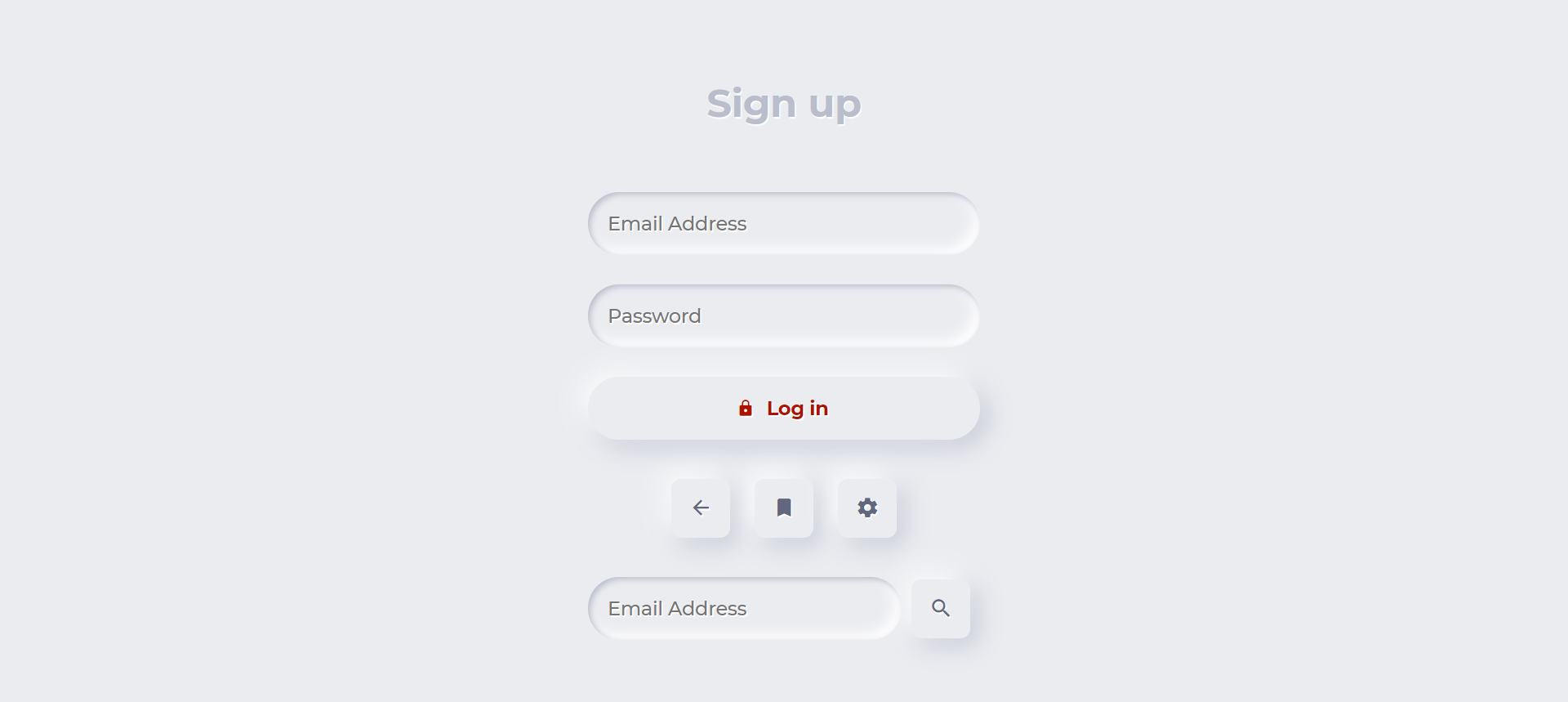
Use os seguintes trechos de código HTML e CSS para criar a forma neumórfica acima.
Código HTML
<!DOCTYPE html>
<html lang="en" dir="ltr">
<head>
<meta charset="utf-8">
<title>Neumorphic Form</title>
<link rel="stylesheet" href="https://unpkg.com/[email protected]/dist/css/ionicons.min.css">
<style>
@import url('https://fonts.googleapis.com/css?family=Montserrat:500,700&display=swap');
</style>
<link rel="stylesheet" href="styles.css">
</head>
<body>
<form>
<div class="segment">
<h1>Sign up</h1>
</div>
<label>
<input type="text" placeholder="Email Address" />
</label>
<label>
<input type="password" placeholder="Password" />
</label>
<button class="red" type="button"><i class="icon ion-md-lock"></i> Log in</button>
<div class="segment">
<button class="unit" type="button"><i class="icon ion-md-arrow-back"></i></button>
<button class="unit" type="button"><i class="icon ion-md-bookmark"></i></button>
<button class="unit" type="button"><i class="icon ion-md-settings"></i></button>
</div>
<div class="input-group">
<label>
<input type="text" placeholder="Email Address" />
</label>
<button class="unit" type="button"><i class="icon ion-md-search"></i></button>
</div>
</form>
</body>
</html>
Código CSS
body, html {
background-color: #EBECF0;
}
body, p, input, select, textarea, button {
font-family: "Montserrat", sans-serif;
letter-spacing: -0.2px;
font-size: 16px;
}
div, p {
color: #BABECC;
text-shadow: 1px 1px 1px #FFF;
}
form {
padding: 16px;
width: 320px;
margin: 0 auto;
}
.segment {
padding: 32px 0;
text-align: center;
}
button, input {
border: 0;
outline: 0;
font-size: 16px;
border-radius: 320px;
padding: 16px;
background-color: #EBECF0;
text-shadow: 1px 1px 0 #FFF;
}
label {
display: block;
margin-bottom: 24px;
width: 100%;
}
input {
margin-right: 8px;
box-shadow: inset 2px 2px 5px #BABECC, inset -5px -5px 10px #FFF;
width: 100%;
box-sizing: border-box;
transition: all 0.2s ease-in-out;
appearance: none;
-webkit-appearance: none;
}
input:focus {
box-shadow: inset 1px 1px 2px #BABECC, inset -1px -1px 2px #FFF;
}
button {
color: #61677C;
font-weight: bold;
box-shadow: -5px -5px 20px #FFF, 5px 5px 20px #BABECC;
transition: all 0.2s ease-in-out;
cursor: pointer;
font-weight: 600;
}
button:hover {
box-shadow: -2px -2px 5px #FFF, 2px 2px 5px #BABECC;
}
button:active {
box-shadow: inset 1px 1px 2px #BABECC, inset -1px -1px 2px #FFF;
}
button .icon {
margin-right: 8px;
}
button.unit {
border-radius: 8px;
line-height: 0;
width: 48px;
height: 48px;
display: inline-flex;
justify-content: center;
align-items: center;
margin: 0 8px;
font-size: 19.2px;
}
button.unit .icon {
margin-right: 0;
}
button.red {
display: block;
width: 100%;
color: #AE1100;
}
.input-group {
display: flex;
align-items: center;
justify-content: flex-start;
}
.input-group label {
margin: 0;
flex: 1;
}3. Navbar Neumorphic
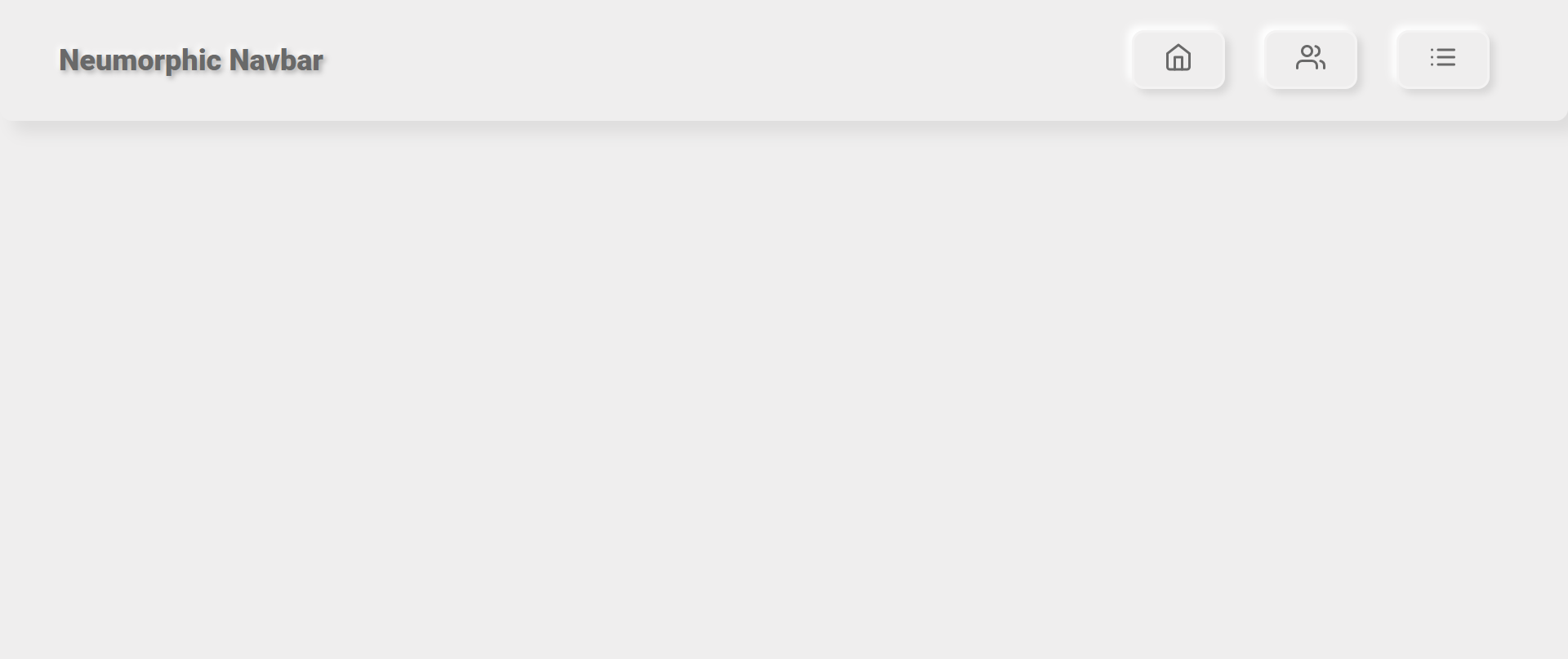
Use os seguintes trechos de código HTML, CSS e JavaScript para criar a barra de navegação neumorfa acima.
Código HTML
<!DOCTYPE html>
<html lang="en" dir="ltr">
<head>
<meta charset="utf-8">
<title>Neumorphic Navbar</title>
<style>
@import url('https://fonts.googleapis.com/css?family=Roboto:400,900&display=swap');
</style>
<link rel="stylesheet" href="styles.css">
</head>
<body>
<ul class="nav">
<li class="logo">Neumorphic Navbar</li>
<li tabindex="0"><i data-feather="home"></i></li>
<li tabindex="0"><i data-feather="users"></i></li>
<li tabindex="0"><i data-feather="list"></i></li>
</ul>
<script src="https://cdnjs.cloudflare.com/ajax/libs/feather-icons/4.24.1/feather.min.js"></script>
<script type="text/javascript" src="script.js"></script>
</body>
</html>Código CSS
* {
margin: 0;
padding: 0;
box-sizing: border-box;
}
body {
background-color: #efeeee;
}
.nav {
width: 100vw;
height: 100px;
background-color: #efeeee;
box-shadow: 10px 10px 12px 0 rgba(0, 0, 0, 0.07);
border-radius: 0 0 10px 10px;
display: flex;
justify-content: flex-end;
align-items: center;
padding: 0 3rem;
list-style-type: none;
}
.nav li.logo {
margin-right: auto;
font-family: "Roboto", sans-serif;
font-size: 1.5rem;
color: dimgray;
font-weight: 900;
text-shadow: 2px 2px 4px rgba(0, 0, 0, 0.3), -2px -2px 4px white;
}
.nav li:not(.logo) {
margin: 0 1rem;
padding: 0.5rem 1.5rem;
border: 2px solid rgba(255, 255, 255, 0.3);
box-shadow: 4px 4px 6px 0 rgba(0, 0, 0, 0.1), -4px -4px 6px white;
border-radius: 10px;
font-family: "Roboto", sans-serif;
cursor: pointer;
transition: color 0.2s ease-out, transform 0.2s ease-out;
color: dimgray;
}
.nav li:not(.logo):hover {
transform: scale(1.05);
box-shadow: 4px 4px 10px 0 rgba(0, 0, 0, 0.1), -4px -4px 10px white;
}
.nav li:not(.logo):focus {
outline: none;
transform: scale(0.95);
box-shadow: 4px 4px 10px 0 rgba(0, 0, 0, 0.1), -4px -4px 10px white, 4px 4px 10px 0 rgba(0, 0, 0, 0.1) inset, -4px -4px 10px white inset;
}
.nav li:not(.logo):hover, .nav li:not(.logo):focus {
color: orangered;
}Código JavaScript
feather.replace();4. Texto e formas neumórficas
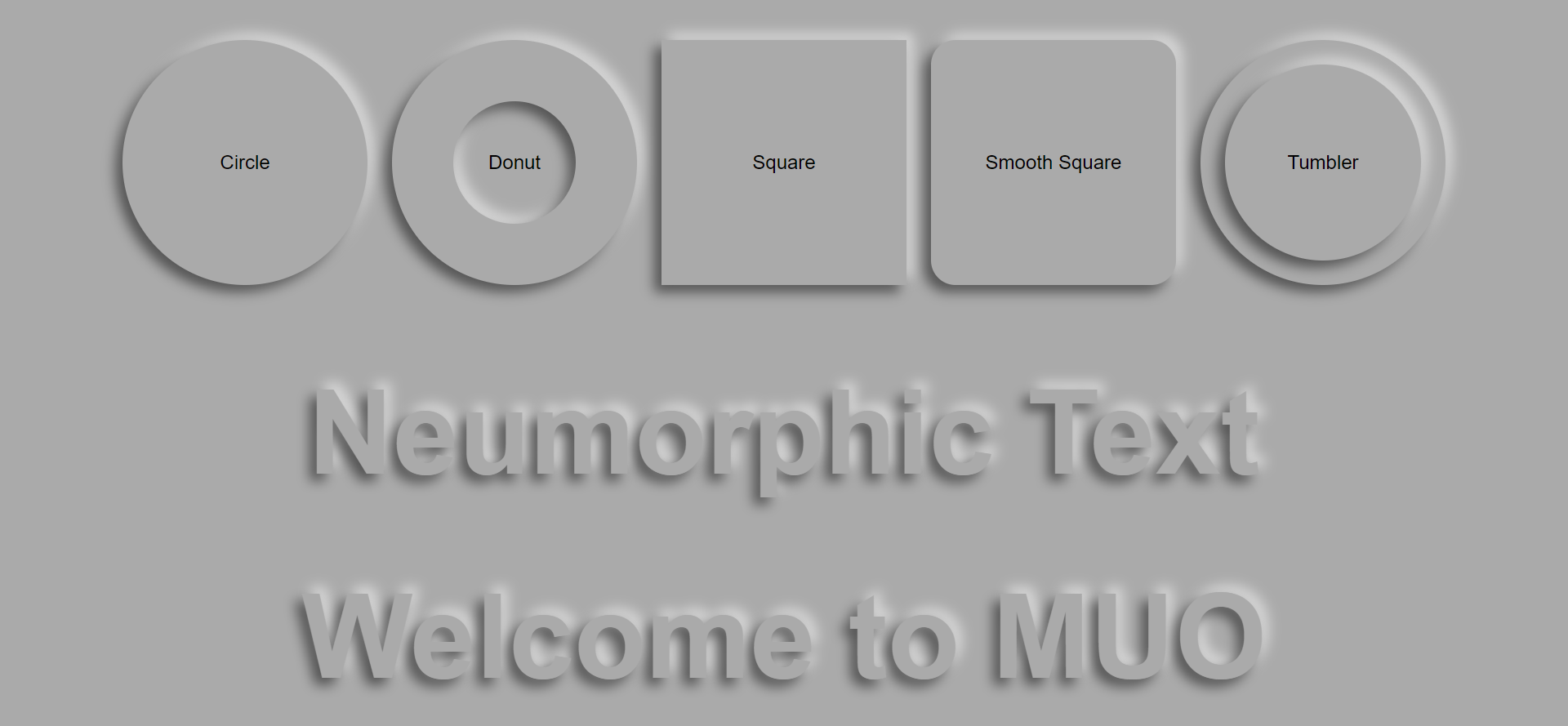
Use os seguintes trechos de código HTML e CSS para criar o texto e as formas neo-tumorais acima.
Código HTML
<!DOCTYPE html>
<html lang="en" dir="ltr">
<head>
<meta charset="utf-8">
<title>Neumorphic Text and Shapes</title>
<link rel="stylesheet" href="styles.css">
</head>
<body>
<div class="n-outset n-circle">Circle</div>
<div class="n-outset n-donut"><div class="n-inset">Donut</div></div>
<div class="n-outset n-square">Square</div>
<div class="n-outset n-smooth-sq">Smooth Square</div>
<div class="n-outset n-tumbler"><div class="n-outset">Tumbler</div></div>
<div class="n-text">Neumorphic Text</div>
<div class="n-text">Welcome to MUO</div>
</script>
</body>
</html>Código CSS
*, *::before, *::after {
box-sizing: border-box;
}
:root {
--nColor: #aaa;
--brShadow: -6px 6px 10px rgba(0,0,0,0.5);
--tlShadow: 6px -6px 10px rgba(255,255,255,0.5);
}
body {
margin: 0;
font-family: sans-serif;
min-height: 100vh;
display: flex;
align-items: center;
justify-content: center;
flex-wrap: wrap;
background: var(--nColor);
}
.n-outset,
.n-inset {
display: flex;
align-items: center;
justify-content: center;
}
.n-circle {
background-color: var(--nColor);
box-shadow: var(--brShadow), var(--tlShadow);
border-radius: 50%;
width: 200px;
height: 200px;
margin: 10px;
}
.n-donut {
background-color: var(--nColor);
box-shadow: var(--brShadow), var(--tlShadow);
border-radius: 50%;
width: 200px;
height: 200px;
margin: 10px;
}
.n-donut .n-inset {
background-color: var(--nColor);
box-shadow: inset var(--brShadow), inset var(--tlShadow);
border-radius: 50%;
width: 50%;
height: 50%;
margin: 0;
}
.n-tumbler {
background-color: var(--nColor);
box-shadow: var(--brShadow), var(--tlShadow);
border-radius: 50%;
width: 200px;
height: 200px;
margin: 10px;
}
.n-tumbler .n-outset {
background-color: var(--nColor);
box-shadow: var(--brShadow), var(--tlShadow);
border-radius: 50%;
width: 80%;
height: 80%;
margin: 0;
}
.n-square {
background-color: var(--nColor);
box-shadow: var(--brShadow), var(--tlShadow);
border-radius: 0;
width: 200px;
height: 200px;
margin: 10px;
}
.n-smooth-sq {
background-color: var(--nColor);
box-shadow: var(--brShadow), var(--tlShadow);
border-radius: 10%;
width: 200px;
height: 200px;
margin: 10px;
}
.n-text {
color: var(--nColor);
text-shadow: var(--brShadow), var(--tlShadow);
font-size: 6em;
font-weight: bold;
}5. Botões neumórficos
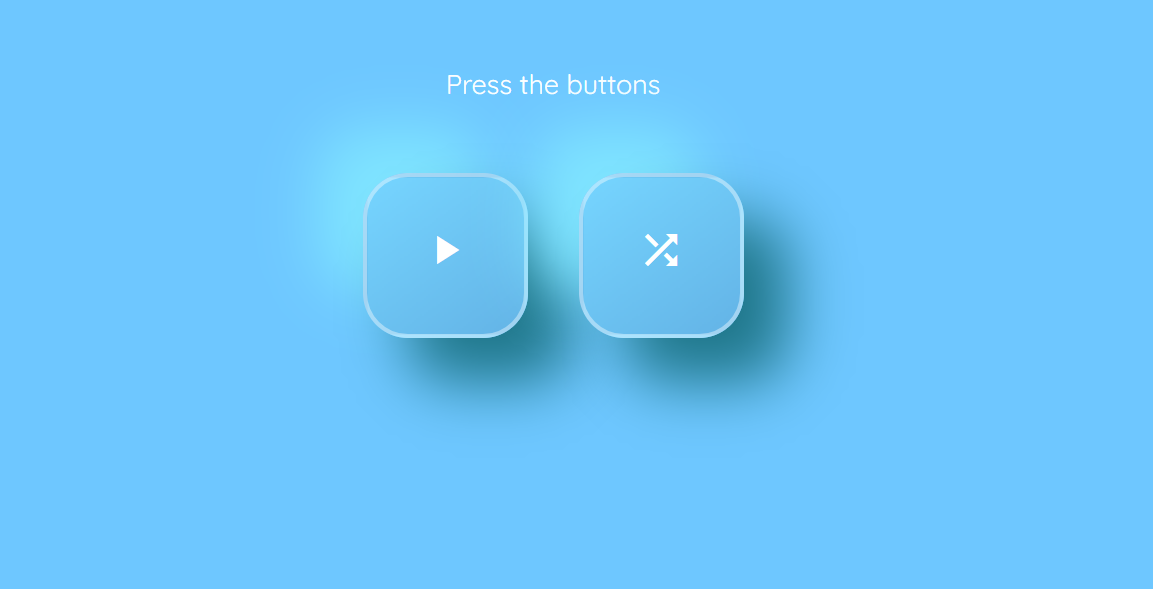
Use os seguintes trechos de código HTML, CSS e JavaScript para criar os botões neumorosos acima.
Código HTML
<!DOCTYPE html>
<html lang="en" dir="ltr">
<head>
<meta charset="utf-8">
<title>Neumorphic Buttons</title>
<link href="https://fonts.googleapis.com/css?family=Quicksand&display=swap" rel="stylesheet">
<link rel="stylesheet" href="styles.css">
</head>
<body>
<div class="btn-holder">
<p class="intro-text">Press the buttons</p>
<button id="play-pause" onclick="changeStyle('play-pause')" aria-label="Play/Pause Button." class="btn neumorphic">
<span class="icon">
<i id="play" class="material-icon">
play_arrow
</i>
<i id="pause" class="material-icon">
pause
</i>
</span>
</button>
<button id="shuffle-btn" onclick="changeStyle('shuffle-btn')" aria-label="Shuffle Button." class="btn neumorphic">
<i id="shuffle" class="material-icon">
shuffle
</i>
</button>
</div>
<script type="text/javascript" src="script.js"></script>
</body>
</html>Código CSS
@import url('https://fonts.googleapis.com/icon?family=Material+Icons');
body{
background-color: #6ec7ff;
}
.btn-holder{
display: block;
margin: 0 auto;
margin-top: 64px;
text-align: center;
}
.intro-text{
margin-bottom: 48px;
font-family: 'Quicksand', sans-serif;
color: white;
font-size: 18px;
}
.btn{
width: 110px;
height: 110px;
font-size: 30px;
border-radius: 30px;
border: none;
color: white;
vertical-align: top;
-webkit-transition: .6s ease-in-out;
transition: .6s ease-in-out;
}
.btn:hover{
cursor: pointer;
}
.btn:focus{
outline: none;
}
.btn:first-of-type{
margin-right: 30px;
}
.neumorphic{
background: linear-gradient(145deg, #76d5ff, #63b3e6);
box-shadow: 30px 30px 40px #1e7689,
-30px -30px 40px #7fe5ff;
border: 3px solid rgba(255, 255, 255, .4);
}
.neumorphic-pressed{
background: linear-gradient(145deg, #63b3e6, #76d5ff);
-webkit-box-shadow: inset 15px 15px 20px -20px rgba(0,0,0,.5);
-moz-box-shadow: inset 15px 15px 20px -20px rgba(0,0,0,.5);
box-shadow: inset 15px 15px 20px -20px rgba(0,0,0,.5);
}
.neumorphic:focus, .neumorphic:hover, .neumorphic:focus, .neumorphic:hover, .neumorphic-pressed:focus, .neumorphic-pressed:hover {
border: 3px solid rgba(46, 74, 112, .75);
}
.material-icon {
font-family: 'Material Icons';
font-weight: normal;
font-style: normal;
font-size: 32px;
display: inline-block;
line-height: 1;
text-transform: none;
letter-spacing: normal;
word-wrap: normal;
white-space: nowrap;
direction: ltr;
-webkit-font-smoothing: antialiased;
text-rendering: optimizeLegibility;
-moz-osx-font-smoothing: grayscale;
font-feature-settings: 'liga';
}
#pause {
color: #143664;
display: none;
}Código JavaScript
function changeStyle(btnPressed) {
var btn = document.getElementById(btnPressed);
btn.classList.toggle("neumorphic");
btn.classList.toggle("neumorphic-pressed");
if (btnPressed === 'play-pause') {
play();
} else if (btnPressed === 'shuffle-btn') {
shuffle();
}
}
function play() {
var playBtn = document.getElementById('play');
var pauseBtn = document.getElementById('pause');
if (playBtn.style.display === 'none') {
playBtn.style.display = 'block';
pauseBtn.style.display = 'none';
} else {
playBtn.style.display = 'none';
pauseBtn.style.display = 'block';
}
}
function shuffle() {
var shuffleBtn = document.getElementById('shuffle-btn');
if (shuffleBtn.style.color == 'white' || shuffleBtn.style.color == '') {
shuffleBtn.style.color = '#143664';
} else {
shuffleBtn.style.color = 'white';
}
}Se você quiser dar uma olhada no código-fonte completo usado neste artigo, aqui está o repositório GitHub .
Observação : o código usado neste artigo é licenciado pelo MIT .
Estilize seu site com neumorfismo
Você pode usar o conceito de design minimalista de neumorfismo para estilizar seu site. Ele fornece uma aparência esteticamente agradável. Mesmo assim, o neumorfismo tem limitações de acessibilidade.
Existem diferentes maneiras de dar uma aparência elegante a um site. Se você quiser estilizar caixas brandas em seu site, experimente a propriedade CSS box-shadow.

